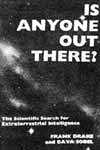Sign language from outer space
 THE TITLE reminds you of the Edwardian English poet, Walter De La Mare's The Listeners: "'Is there anybody there,' said the traveller?" While De La Mare's traveller rode through time seeking responses, Drake's creatures hover through space. Earth has possibly never been visited by an Unidentified Flying Object (UFO) that turned out to be a spacecraft from another planet; nor are we likely to receive such a visit in the future.
THE TITLE reminds you of the Edwardian English poet, Walter De La Mare's The Listeners: "'Is there anybody there,' said the traveller?" While De La Mare's traveller rode through time seeking responses, Drake's creatures hover through space. Earth has possibly never been visited by an Unidentified Flying Object (UFO) that turned out to be a spacecraft from another planet; nor are we likely to receive such a visit in the future.
Thankfully, in place of age-old dreams of close encounters with alien astronauts, this book holds out the real possibility of radio contact with an unlimited number of intelligent galactic. Internationally renowned astronomer Francis Drake has been scanning deepest space for over 30 years, hoping to tune into an alien signal that could only come from a extraterrestrial intelligence. With a huge body of data and armed with new body of evidence of the existence of other planetary systems, he has established the search for extraterrestial intelligence as a global enterprise, headed by NASA programmes, in which the world's most powerful radio telescopes are playing a vital role.
This gripping book chronicles the saga of Drake's work and discoveries, travelling to remote observatories and going behind the closed doors of international conferences. Some of the world's most eminent scientists have worked with Drake to untangle the practical problems of detecting signals from other sentient beings. Where should the telescopes be pointed? What frequency should be used? If an alien signal is detected, how should we respond? What should we want to communicate about ourselves? What do we stand to gain from interstellar contact?
With convincing photographs and imaginative explanations, the book's clear explanations of the scientific ideas and technology enable every reader to share in the excitement of a quest that could have awesome consequences. Drake writes, "From a distance of a hundred yards at twilight, you might almost mistake them for human. I think they will walk on two legs, too, as we do, but I suppose that, more often than not, intelligent extraterrestials will have four arms instead of two. Four make for a better design."
It was in 1959 that Drake engineered his first efforts at the National Radio Astronomy Observatory in Green Bank, West Virginia. Project Ozma was named after a distant inaccessible land, populated by strange and exotic beings. Drake notes that he used crude instruments in the '60s to listen for signals from two nearby, sunlike stars. It took two months to complete the job. Today, perhaps, we could repeat Project Ozma within a fraction of a second. And more: we could scan for signals from a million stars or more at a time, at distances of over 1,000 light years.
Drake says, "Such a search is not only possible, it is all planned out, poised, and ready to begin at the time the book is published. There no way, of course, to verify the scientists' claim." Drake's logic is firm. He argues that even till the '80s, the fact that we had not yet found another civilisation, despite continued global efforts and better equipment, simply means we had not looked long enough or deep enough. The NASA committed $100 million to a formal SETI (Search for Extra Terrestrial Intelligence) mission spanning the '90s decade, making the work a priority for the space agency and guaranteeing that coveted telescope time will be devoted to be search.
The point of this book is that interstellar contact will enrich our lives immeasurably. In all likelihood, any civilisation we can detect, according to the author, will be more advanced that our own, providing us with a glimpse of what Earth's future could be. For once, readers will enjoy the history of the future, not just the past.
